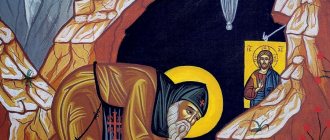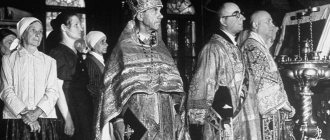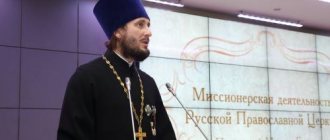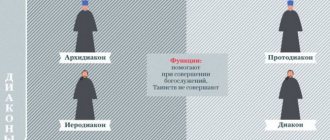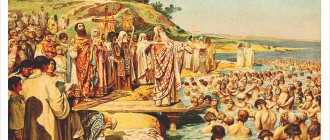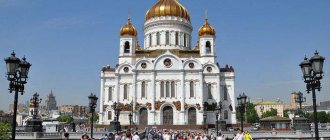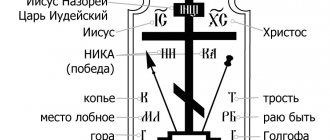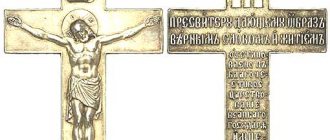A church choir is called a choir; this word is also used to describe the place where the choir stands in a church. Those people who often visit an Orthodox church know that the basis of the service is church singing. One can hardly imagine any church service without it. A lot depends on singing in church; poor singing disrupts prayer and makes you distracted. Too pretentious “operatic” singing also distracts from prayer. Correct singing in church should humble a person and put him in the right prayerful mood. That is why priests attach such importance to the selection of singers.
Why is singing necessary in church?
So why is singing necessary in the temple? Because a temple is a house of prayer, and prayer is the highest expression of the human spirit on earth. And therefore, as accurately noted in the book “Art and Orthodoxy” by Alexander Khudozhin, “prayer often strives to embody itself in harmonious musical sounds, which not only serve as beautiful clothing for it, but are also wings that lift it to heaven.” That is, singing makes prayer more sublime.
The article by Archpriest I. Voznesensky “On the high dignity and beneficial influence of church singing on people” says that singing reveals “the deepest spiritual states, the most noble, sublime and holy feelings better than words, facial features and gestures.” the delight of our spirit (that is, both the singers and the parishioners - author’s note) the fire of noble animation.”
John Chrysostom has a conversation on the 41st Psalm (which, by the way, we love to sing in a special, monastic tune), where the saint answers the question: what is church singing used for? And he gives the following explanation: “ God , seeing that many people are careless, are burdened by reading spiritual scriptures and reluctantly take on this work, and wanting to make this work desirable and destroy the feeling of fatigue, combined the melody with the prophecies. In fact, nothing elevates so much and does not inspire the soul, does not separate it from the earth, does not deliver it from the bonds of the body, does not dispose it to philosophize and despise everything worldly, like consonant singing and a harmoniously composed divine song.”
Another important reason for singing in the temple
There is another important reason for singing in the temple. The earthly Church is a reflection and image of the Heavenly Church. And in the Heavenly Church, angels continuously glorify the Lord with jubilant singing. (The thought involuntarily comes to mind that the Lord created our earth round so that the earthly Church would not interrupt its services 24 hours a day, because there are Orthodox churches in every time zone of the globe, in one place the service ends, and in another just starting and so on). In the Holy Scriptures, in the lives of saints and in the testimonies of pious people, we repeatedly encounter the appearance of angels singing praises to the triune God.
The Old Testament prophet Isaiah says that he saw the seraphim surrounding the throne of the Lord and exclaiming to each other: “Holy, holy, holy is the Lord of hosts! The whole earth is full of His glory." The interpretation of this passage in the Bible says that, apparently, the seraphim were divided into two faces and choirs, which alternately (and therefore antiphonally) proclaimed praise to God.
The New Testament seer, Evangelist John the Theologian, in various places of his Apocalypse, mentions the singing of the blessed celestial beings surrounding the throne of the Lord: cherubim, angels, a host of holy men of all tribes and tongues, who in different expressions with the refrain “Alleluia” sang the praises of God and the Lamb.
Saint Ignatius the God-Bearer saw angels chanting the Holy Trinity with alternating songs - and he introduced this image of antiphonal singing into the Antiochian Church. In our large monasteries, to this day, monks sing antiphonally (this is very impressive, as an image of the continuous angelic glorification of God). And individual liturgical chants are called antiphons, although they are sung by one choir or choir.
Ordinary people also had the honor of hearing angelic singing. I will give only the most famous examples. In 439, during an earthquake in Constantinople, the youth, caught up in the air, heard angels singing “Holy God, Holy Mighty, Holy Immortal”; people repeated these words, adding “have mercy on us,” and the earthquake stopped. Since that time, the Trisagion has been established to be sung or read at every Orthodox service.
And who does not know that the Bethlehem shepherds saw and heard many angels praising God and singing in honor of the birth of Christ the Savior: “Glory to God in the highest and on earth peace, good will toward men.” These words are now also sung or read at the beginning of each Matins before the Six Psalms.
Hymns of the Orthodox Church
Antiquity of the use of sacred chants
Singing was part of the worship of the Old Testament Church. In the Christian Church, the use of singing is sanctified by the example of Jesus Christ, who after the Last Supper sang with His disciples.
Undoubtedly, singing has been part of worship since apostolic times. Ap. Paul ordered the Ephesians and Colossians to admonish each other with psalms, hymns and spiritual songs, meaning singing specifically during public worship, and not private.
With particular clarity, the use of singing during divine services in apostolic times is revealed from the Epistles of St. Paul to the Corinthians. Here the apostle, indicating what kind of hymns should be in the liturgical assemblies of Christians, at the same time notes: Let everything happen in order and in order (1 Cor. 14:40), which gives the right to think that singing was not only part of the divine service, but and had its own order and was performed according to the order established by the apostles.
Since then, singing has never ceased to be one of the main parts of Christian worship.
The difference between Christian chants according to their origin
Already in the worship of the apostolic times, three types of chants are distinguished: psalms, hymns and spiritual songs.
Regarding the Psalms
David, they have a very extensive use in the worship of the Orthodox Church.
The second row consists of hymns
. This name refers to the so-called hymns of the Old Testament fathers, namely: the song of Israel, sung upon crossing the Red Sea (Ex. XV, 1-19), the accusatory song of Moses (Deut. XXXII, 1-43), the song of Anna, mother Samuel (1 Samuel II, 1–10), songs of the prophets: Isaiah (Isaiah XXVI. 9–17). Habakkuk (III, 1–12), Jonah (II, 3–10), the song of the three Babylonian youths (Dan. III, 24–90). This also includes: the song of the Mother of God (Luke I, 46–55), the prayer of Simeon the God-Receiver (Luke II, 29–32), the prayer of Zechariah (Luke I, 68–79).
The use of all these hymns in Christian worship is contemporary with the beginning of the use of psalms. In the 4th and even 3rd centuries there are interpretations of these hymns by St. Hippolytus, Didymus, Eusebius and Theodore of Irakli. The songs of the Old Testament righteous are especially remarkable in that they were accepted by St. John of Damascus for the founding of the canons he compiled. The reason for this was, without a doubt, their long-standing use during divine services, due to which some hermits, even when compiling troparions, used these songs instead of troparia.
The songs of the Old Testament righteous were included in the canons in the following order: the first song of the canon is modeled on the song of Moses upon crossing the Red Sea; the second is modeled on the accusatory song of Moses before his death to the people of Israel, who had forgotten the blessings of God; the third is modeled on the song of St. Anna, the mother of Samuel, and depicts the Church before the coming of Christ as not being fruitful, like the mother of Samuel, but now rejoicing over her many children: the fourth is modeled on the song of the prophet Habakkuk, who foresaw the coming of Christ; the fifth is modeled on the song of the prophet Isaiah, praising the deliverance of the Church from enemies: the sixth is modeled on the song of the prophet Jonah, who struggled with death in the belly of the whale, and depicts the state of a sinner whose soul is filled with evil and his belly is approaching hell; the seventh and eighth songs are modeled after the songs of the three youths, who confessed God’s judgment over them and the people of Israel and called upon all creation to glorify the Lord for keeping them unharmed.
The content of the ninth song, always preceded by the song of the Mother of God, is borrowed from the prophetic song of Zechariah, the father of John the Baptist.
Finally, the third category - spiritual songs
. This name designates songs composed and composed by Christians themselves under the inspiration of the spirit of grace.
They are the fruit of the Christian’s own spirit and are completely imbued with the spirit of grace and truth of Christ.
With the bringing of grace and the revelation of the truth of Christ, the Church had to glorify God and depict His glory more expressively, accurately and in detail than was possible in the songs of the Old Testament.
This is the significant difference between spiritual songs and the chants of the first two categories.
We find examples of this type of chants already in the Holy Scriptures. This is the song of thanksgiving sung by the faithful on the occasion of the miraculous salvation of St. Peter and John and prison (Acts 6:23–30).
The context of the speech, as well as the rhythmic meter, close to the meter of the Old Testament songs, give the right to consider the following passages as excerpts from the songs of the apostolic Christians:
arise from sleep, and rise from the dead, and Christ will illuminate you
(Eph. 5:14);
Greatness is the mystery of piety: God appeared in the flesh, I was justified in Dus, appeared as an angel, was preached to the nations, believed in the world, ascended in glory
(1 Tim. 3:16);
The word is true: if we die with Him, we will live with Him. If we endure, we will reign with Him; if we reject, He will reject us. Even if we do not believe, He is more faithful than ever: for He cannot deny Himself
(2 Tim. 2:11–12).
Based on the practice of the apostolic times, the Church subsequently develops and processes this type of chant with particular strength and variety.
Names of church songs
The first category consists of songs that borrow their name from the content:
Risen
. These are songs whose general subject or theme is the glorification of the resurrection of Christ. And since the memory of this event is timed to coincide with Sunday, the name also indicates the time of use of these songs.
Holy Cross
. Its content is the memory of the suffering and resurrection of the Savior;
Theotokos.
This is the name of the songs composed in honor of the Mother of God;
Holy Cross.
It got its name because it remembers the crying of the Virgin Mary at the cross of the Savior. They are sung on Wednesdays and heels;
Dogmatist.
These songs, along with praises of the Mother of God, contain dogmatic teaching about the person of our Lord Jesus Christ, mainly about the incarnation and union of two natures in Him. Compiler of dogmatists - St. John of Damascus. The Theotokos dogmatists are sung after the stichera on the Lord, I cried and after the stichera on the stichera;
Lamps.
These chants are sung at Matins after the canon and are called so because they mostly contain a prayer for enlightenment from above. Sometimes exapostilaria are designated by this name. The lamps for all voices are usually placed separately at the end of the octoechus. In other books they do not have a voice inscription (in the menaions and triodes);
Exapostilarium.
This song is also sung after the canon at Sunday Matins and replaces the everyday chanting. The Sunday exapostilaria were compiled by Emperor Constantine Porphyrogenitus;
Trinity.
Their general content is the glorification of the Holy Trinity. They are sung at Matins, when after the Six Psalms and Litany the following is sung: Alleluia, and not sung during the singing: God is the Lord. They relate to the service of the day and are sung in a voice that is sung in a row during the week;
Martyred.
These are songs in honor of martyrs. They are sung according to the Octoechos on all days of the week at Vespers - in stichera at the stichera (on Saturday - and I cried out to the Lord), at Matins - in the sedals, in the canons (except Thursday) and in stichera at the stichera, at the Liturgy - at the Blessed;
Repentant and touching.
The common theme of these songs is confessing sins to God, lamenting them, and praying for forgiveness. They are laid out at the services of Monday and Tuesday in the modified hymns of the Octoechos;
Dead and at rest.
They contain prayers for the departed. They are placed only in the Saturday service, since on this day the Church remembers the departed. Morphary troparia for the immaculate, sung at burial, also belong here.
The second category consists of chants, the names of which indicate their volume. These are:
Stichera.
This is the name for chants consisting of many verses, written in one meter and mostly preceded by verses of the Holy Scriptures. This name was transferred from the Old Testament poetic writings, which the ancient Fathers of the Church called stichera, according to the model and to replace which Christian stichera began to be compiled. According to the difference in the verses of Holy Scripture preceding the stichera, these latter are distinguished into three types:
1
. stichera on the Lord, I have cried - these are those that are sung at Vespers and have before them verses from 140 (Lord, I have cried), as well as from Psalms 129 and 141;
2
. stichera are verse or in verse. They differ from the first stichera in that they contain verses not from the indicated psalms, but from various others, as well as from the books of Holy Scripture in general, which verses are selected according to the memory of the day and to which denomination the saint belongs. These stichera are sung at Vespers and Matins;
3
. stichera on praise - those that have before them verses from the so-called psalms of praise - 148, 149 and 150, in which the words often appear: praise.
Kontakion and Ikos.
These chants depict the essence of the holiday or praise of the saint, with the difference, however, that in the kontakion this content is presented briefly, and in the ikos - at length. These chants are also similar in appearance: they are written in the same meter, mostly end with the same words and are sung in the same voice. In terms of their content, kontakion and ikos usually serve as a model for the entire sequence to which they belong: kontakion is, as it were, a theme of succession, the development of which is proposed in ikos. Therefore, ikos are always delivered after kontakions and never before. Regarding size, presentation and voice, the kontakion and ikos serve as a model for other hymns that follow.
Among the compilers of kontakia and ikos, Roman the Sweet Singer, who lived in the 5th century, is especially famous.
Songs of the third category take their names from the composition, size and manner of singing. These are:
Canon.
An extensive chant, composed according to well-known rules from the combination of several songs or odes, written in the same poetic meter, into one harmonious whole. The chant itself gets its name from the correctness and harmony of combining individual parts into one whole. The canon consists of nine songs and serves as a depiction of the heavenly hierarchy and its songs. Such a canon is called complete. But it can contain four, three or two songs. In the whole canon, one thought is revealed, for example, the Resurrection of the Lord, the Cross of the Lord, the Mother of God, etc. are glorified. On this basis, each canon has special names, for example, the Resurrection Canon, the Canon of the Life-giving Cross of the Lord, the Canon of the Theotokos, etc. .
Each individual canticle of the canon consists of several verses. The first verse of each song is called irmos
.
Irmos are based on songs borrowed from the Holy Scriptures. At the same time, the irmos serves as a model and connection for subsequent verses, informs them of the order regarding the number of feet and lines and the tone of their singing. The following verses are called troparia
. A special irmos attached to the end of each song is called katavasiya (performed by both faces). In addition, the entire canon is divided into three parts by small litanies. The canons appear in Christian worship very early, but in their original form they were a series of troparia or stichera without irmos.
The first Irmos were compiled by St. John of Damascus, he also brought the troparia into a harmonious whole and informed the canon of its real form.
Antiphons.
These are songs that are sung in both choirs alternately. There are several types of antiphons:
1
.
Antiphons of kathismas.
This is what the parts or Glory of Kathisma are called, because the charter prescribes that the verses of Kathisma should be sung alternately by two faces;
2
.
Figurative antiphons
from Psalms 103 and 145, sung at the liturgy after the Great Litany. When figurative antiphons are sung, then instead of the third antiphon the Blessed Ones are sung and between them the troparia of the 3rd and 6th or another song of the Matins canon;
3
.
Everyday antiphons,
consisting of Psalms 9, 92 and 94 and sung instead of the Blessed and pictorial psalms, when the rules do not specify the songs of the canon for singing on the Blessed;
4
.
Festive antiphons
sung on the twelve feasts of the Lord;
5
.
Power antiphons.
These are Sunday morning antiphons, so named because they were composed by St. John of Damascus in relation to the 15 psalms (from 119 to 133), which the Jews called songs of degrees;
Similar, self-similar and self-agreeable.
These names are assigned to some songs of the Menaion when the voice in which they should be sung is indicated, for which purpose the songs themselves are inscribed with the indicated names.
Similar
A song that in content, but more often in size or tone, or both together, is similar to another song of Menaea or Octoechos, the initial words of which are written immediately after the word: similar. Almost always a song similar to another in size is also similar in voice.
Self-similar and self-agreeable
They differ from similar ones in that no other song served as a model for them, neither in content, nor in size, nor in voice. The difference between self-similar and self-vocal is the following: two or three songs are called self-similar, which, although not composed in the likeness of others, are, however, similar to each other in size, tone and content, and even literally. The voice to which they should be sung is indicated in front of them. Self-concordant are songs that are written completely independently regarding size, tone and content, and the voice in which they are sung is assigned to them in relation to their content, regardless of other songs.
For self-vocalists, special tunes have been invented that differ from ordinary church voices. However, the voice of Octiochos is often inscribed above them, to which they should be sung;
Inert.
Peculiar melodies, distinguished by protractedness, with which some chants are sung, for example, sacraments and magnifications. The fourth category consists of names indicating the position and condition of the worshipers during singing. These are:
Akathist.
It is forbidden to sit while singing the akathist. Initially, this name was adopted by songs of thanksgiving in honor of the Mother of God, sung in Constantinople on the occasion of deliverance from enemies in 626. This akathist consists of 24 songs, according to the number of letters of the Greek alphabet. 12 of them are kontakia and 12 are ikos. They are located in such a way that the kontakion and ikos constantly follow one another. The theme of the akathist is the first kontakion: To the chosen governor the victorious...
The entire akathist is divided into two parts, of which the content of the first (up to the seventh ikos) is historical, and the second is dogmatic.
Subsequently, the name of the akathist was transferred to other chants composed according to the same principle: to the Sweetest Jesus, St. Nicholas and other saints.
Sedalen.
The name is opposite to the first and denotes a chant, during which one was allowed to sit until listening to the reading that took place on the sedalny, which consisted of an interpretation of the Apostle, the Gospel, or in a description of the life of a saint, a holiday, etc. The sedalny rely on matins after kathismas, polyeleos and on 3rd song of the canon, followed by a “reading”. However, permission to sit is not necessarily associated with the name sedalina, and there are sedalina that must be heard while standing.
Ipakoi.
This song is sung at Sunday vigil, also at the Midnight Office after the canon, at Matins before the antiphons and reading of the Gospel, and at the 3rd song of the canon after the sedalna. The charter prescribes singing with ipaka always while standing.
The fifth category includes chants that take their name from the time they are performed in the order of church services. These are:
Luminaires.
Sung after the prayers of the lamp (Blessed is the man).
Prokeimenon.
This is the name of the verse that precedes the reading of Holy Scripture: Apostle, Gospel, proverb. It is borrowed from the Holy Scriptures and briefly indicates either the content of the reading or the meaning of the day and the prayers of the day. Hence the prokeimnas are distinguished into the prokeimnas of the Apostle and the prokeimnas of the day. The prokeimenon of the day is pronounced at Vespers, while at the liturgy the prokeimenon of the apostle and the day are pronounced. Each prokeimnu is accompanied by a verse that is in close connection with it.
In addition to those indicated, there are also great prokemenas, sung at the vespers of the weeks of Great Lent and the Lord's feasts and differing from the first in that they have not one, but three verses.
Alliluary.
A verse that precedes a reading from the Gospel, for which it serves as a preface. It is used when singing alleluia, from which it gets its name. Also called simply alleluia. In addition to its relationship to the Gospel reading, the alleluia can also be related to the service, and is then called: alleluia of the day, alleluia of the voice and alleluia of the holiday.
Involved.
A verse sung during clergy communion.
Release notes.
Hymns sung at the end of Vespers and Matins (for God is the Lord and for Good). The troparia, kontakion and theotokos are absolution.
The sixth category consists of chants, which received their names from those passages of Holy Scripture with which their singing is connected. These are:
Blessed are you.
Troparions sung with chorus 12th century. Psalm 118: Blessed art thou, O Lord, teach me by thy justification;
Immaculate.
17 kathisma in the sequences of burials and others: more often - the first article of this kathisma in the rites of burial, since the rest here have special names (Your 2nd Commandments and Your 3rd Name) from the last words of the first verse;
Blessed.
This is the name of the well-known Gospel verses about the beatitudes (Matthew 5: 3 - 12) and those hymns (usually the troparia of the canon) that are sung at the liturgy following these verses. Most often, the name Blessed is used in the latter sense and denotes the troparia of the canons for singing with verses about the beatitudes;
Praiseworthy.
Psalms of praise and stichera connected with it;
Polyeleos.
Singing Psalms 134 and 135. It got its name from the frequent repetition in these psalms of the word: mercy and from the abundant burning of oil during singing.
Church singing is not arbitrary
Many more examples can be given, but it is enough to note that in our Orthodox Church, singing is sanctified by the examples of the Lord himself and the Mother of God, established by the apostles, multiplied and ordered by the holy fathers.
In the 26th chapter of the Gospel of Matthew, we read that, having celebrated the last Easter supper in his earthly life and giving it a special, new meaning - the first Christian service in connection with the establishment of the sacrament of the Eucharist - Christ ascended with his disciples to the Mount of Olives. In a conversation on this Gospel story, John Chrysostom says: “The Savior sang that we should sing in the same way.” In another conversation (on the 2nd Epistle to the Corinthians), the saint emphasizes that by singing hymns to God, people become associates of the heavenly powers, imitate and become like them.
The holy apostles consolidated the example set by the Savior. In the book of the Acts of the Apostles we read that after the ascension of the Lord, devoting the 3rd, 6th, 9th and midnight hours to prayer, they accompanied the prayer with psalmody. While spreading the teachings of Christ, they made sure that believers did not forget about singing in their prayer meetings (see, for example, the letter of the Apostle Paul to the Ephesians). In the book of the Apostolic Constitutions we find rules that indicate that the apostles not only encouraged liturgical singing, but also legitimized its obligatory nature.
I will not overload our readers with information proving that liturgical singing did not appear in our Church by chance, was not the fruit of human passion or weakness, is not something arbitrary from a canonical point of view, but, on the contrary, was sanctified by the Savior himself, approved by the labors of the apostles and exists in the Church from its first days as an integral condition of public prayer. In addition, liturgical singing goes back to angelic singing itself, for for the first time a song of praise to God was sung by the Ethereal Heavenly forces.
Varieties of church hymns
Two types of chants can be distinguished:
- Liturgical (Divine service). It can be divided into statutory and non-statutory
- Paraliturgical. Not liturgical, non-church.
Types of liturgical (liturgical) singing
Liturgical chant can be divided into 2 types:
- Statutory. Such chants are established by the Typikon. From Greek, “liturgy” is translated as “service”, which is why the songs of other services are called liturgical;
- Extra-temple. They are sung during services, but they are not approved by the Typikon. They are divided into 9 types (akathists, magnifications, canons, at prayer services, spiritual cants, funeral cants, wedding cants, carols, shchedrovki). This type also includes verses sung during the communion of believers at the Liturgy;
Types of paraliturgical chants
Paraliturgical chant is divided into 7 types:
- Repentant. They are usually sung during Lent. Such melodies are slow and sad. You can include, for example, “Behold the Bridegroom will come at midnight”;
- Lenten. They are similar to penitential ones, sung during Lent. Their tempo is slow, and their motive is serious and sad;
- Wedding. They are sung when a wedding takes place. The motive is funny. These include, for example, “Glory to Thee, God, glory to Thee”;
- Funeral. They are sung during remembrance. They sound mournful, tragic, the tempo is leisurely. These include, for example, “Eternal Memory”;
- Easter. They are sung during the Easter Week services. They sound festive. As an example, “Resurrection Day”;
- Carols. The name comes from the word caroling. They are sung during Christmas, after Christmastide. They are short poems for which they give a reward in the form of sweets;
- Shchedrovki. They are similar to carols, sung on the occasion of the old New Year. You can also get a sweet reward for them;
Singing is an elevated state of mind
In general, the ability to sing is a distinctive property only of angels and people, and singing serves as both a means of expressing the high feelings of worship inherent in their nature. Singing is an elevated state of mind. I think this is why representatives of hard rock and rap style, whose screams and tongue twisters are often heard on the radio waves, cannot sing (in the literal sense of the word). That is why demons cannot sing and never sing, we will not find any evidence of this anywhere, the former angels have forever lost their high feelings. A priest talks about this when he comments on a young man’s tape recording of the singing of angels on Mount Athos today (this recording can be found on the Internet: https://www.youtube.com/watch?v=18im76TsOZA).
Holy Mount Athos, skete of Agia Anna (Holy Righteous Anna, mother of the Blessed Virgin Mary, founded in the 14th century)
This is a real miracle. It is no coincidence that it became the property of many people, and that this happened precisely in Greece, the country that longest preserved the traditions of ancient Byzantine singing, but today in many Greek temples it is replaced by partes (polyphonic) singing. It has been established that the angels on the Athos recording sing the Cherubic Hymn of the ancient Byzantine chant. The priest is convinced that angels do nothing for nothing. Since there is a process of secularization, the secularization of church culture, the purpose of the appearance of angels and their unhidden singing was probably the desire to influence the consciousness of modern people.
In our Orthodox churches, unfortunately, they use predominantly partes (polyphonic) singing, which by its nature is not suitable for describing the phenomena of the spiritual world, but is suitable only for describing bodily, worldly phenomena, for expressing passions, for the play of feelings.
